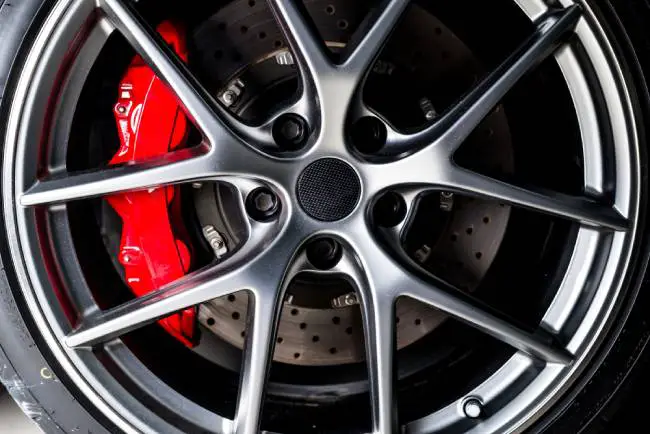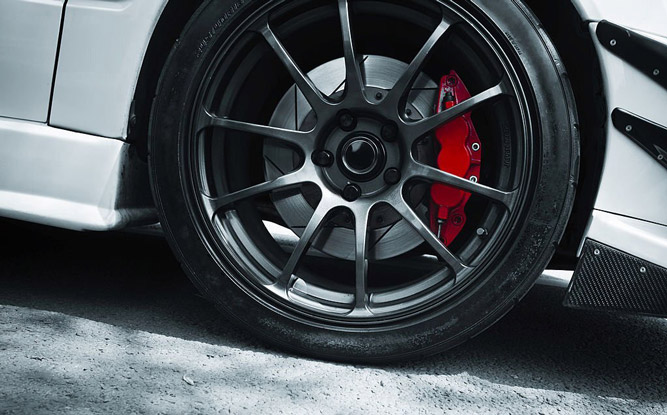Brake calipers are one of the most important parts of the brake system whose job is to apply force necessary to slow down or stop a car completely.
Here we will introduce three different types of brake calipers to you so your technical car knowledge is significantly improved that you can later boast of!
Types of Brake Calipers

1. Floating caliper
Floating calipers use a single piston to move the inboard so it makes contact with the inner side of the brake rotor.
The force of the contact between the inboard pad and the brake rotor causes the caliper to float or slide on pins mounted to the steering knuckle or the bracket.
This forces the outside pad to contact the rotor on the outer side. The clamping force on the revolving rotor makes the wheel slow or stop.
The problem is that the braking force becomes insufficient and the inboard pads wear prematurely when the slide pins stick in their bores.
2. Fixed calipers
These calipers are fixed in a place with a bracket that uses pistons on both sides to stabilize them on the rotor.
The brake fluid pressurizes both pistons at a time when you press the brake. The pistons are pushed out to force brake pads that squeeze the rotors.
3. Sliding calipers
Sliding calipers are a type of floating calipers that operate on the same principle with a single piston.
The caliper uses the piston to press the inner brake pad against the rotor. The movable frame caliper then applies force to the outer pad.
Brake Caliper Design and Material Types

1. Caliper material
Older vehicles mostly use cast iron calipers while newer ones have aluminum variants. Each construction material has distinctive advantages and disadvantages.
Cast iron brake calipers cost less to produce. They are sturdy and better at dissipating heat. Calipers made from aluminum are known for their lightweight.
2. Piston material
Caliper pistons have more versatile materials than calipers. They can be chrome plated aluminum, steel, or plastic.
Aluminum caliper pistons weigh less but the material is prone to corroding. Another issue is that aluminum easily transmits heat to the braking fluid.
Steel pistons are more robust and the chances of rust or other forms of corrosion reduces when they are chrome plated.
The problem with steel is that it transmits heat easily, and can cause hydraulic fluid boil and other difficulties.
Plastic pistons don’t conduct heat so there’s no brake fade or fluid boil.
The lightweight material is corrosion resistant but can absorb moisture and swell up. This causes the pistons to stick and present problems with braking.
Aluminum and steel pistons can also encounter sticking problems when the material deteriorates severely.
3. Monobloc vs two-piece caliper design
Monobloc calipers are cast from a single metal piece. They are stronger and have a long lifespan.
The only problem is that their durability and strength come at a higher manufacturing cost.
Two-piece variants are made from two metal pieces that are joined by bolts.
These calipers are less expensive and easier to make but lack the strength of the monobloc type.
4. Number of pistons
a) Single piston calipers
Single pistons are one of the most common caliper setups but only possible in floating type calipers.
They are great for conventional brakes where high-performance braking isn’t a top priority.
b) Multi-piston
These are employed for higher braking performance but found in both floating and fixed type calipers. The braking performance gets better with more number of pistons.
Piston numbers are selected based on precise calculation and differ from car to car.
There are at least two pistons on each caliper but high-speed and heavy vehicles require up to a 10 piston setup.
Calipers Based on Brake Disc Sizes
| Max disc diameter |
Max disc thickness |
Min disc thickness |
Max pad thickness (mm) | Piston Sizes (mm) |
| 255 | 10 | 8 | 14 | 44 |
| 281 | 31 | 28 | 20 | 29.0/29.0/36.5 |
| 284 | 19 | 18 | 18 | 25.5/29.0 |
| 284 | 20 | 18 | 18 | 25.5/29.0 |
| 313 | 25 | 20 | 20 | 25.5/29.0 |
| 323 | 10 | 8 | 16 | 36.5 |
| 323 | 32 | 28 | 22 | 25.5/29.0 |
| 323 | 32 | 28 | 23 | 41.0/41.0 |
| 323 | 32 | 28 | 29 | 32.0/36.5 |
| 323 | 32 | 32 | 22 | 36.5/41.0 |
| 323 | 35 | 30 | 30 | 36.5/41.0 |
| 323 | 35 | 32 | 29 | 41.0/44.0 |
| 323 | 42 | 40 | 30 | 29.0/36.5/41.0 |
| 323/332 | 32 | 28 | 23 | 36.5/36.5 |
| 323/355 | 32 | 28 | 29 | 25.5/29.0 |
| 330 | 32 | 30 | 19 | 25.5/29.0 |
| 330 | 32 | 30 | 19 | 25.5 / 29.0 |
| 355 | 32 | 28 | 21.5 | 29.0/36.5 |
| 355 | 32 | 28 | 21.5 | 29.0/36.5 |
| 355 | 32 | 28 | 18 | 41.0/44.0 |
| 362 | 35 | 28 | 15 | 36.5/41.0/44.0 |
| 373 | 32 | 30 | 16 | 41.0/41.0 |
| 378 | 32 | 28 | 23 | 29.0/36.5 |
| 378 | 32 | 30 | 29 | 36.5/41.0 |
| 378 | 35 | 32 | 28 | 41.0/41.0 |
| 378 | 37 | 32 | 31 | 36.5/41.0 |
| 378/390 | 35 | 32 | 29 | 29.0/36.5/41.0 |
| 380 | 32 | 30 | 29.95 | 29.0/36.5 |
| 380 | 32 | 30 | 20 | 29.0/36.5 |
| 380 | 32 | 30 | 18 | 29.0/32.0/36.5 |
| 380 | 34 | 32 | 29.95 | 29.0/32.0/36.5 |
| 405 | 36 | 66.5 | ||
| 405 | 36 | 32 | 23.5 | 36.5/41.0/44.0 |
| 405 | 36 | 34 | 22 | 29.0/32.0/36.5 |
What Brake Calipers Should You Use?
Aftermarket pieces may have better chances to get rusted than OEM so use the latter for your safety.
There are reputed aftermarket caliper producers that manufacture parts in the USA or Europe with strict production control. Stick with their products if you need to save some bucks on a caliper purchase.
FAQs
1. Why do some cars have red brake calipers?
Ans. The red color grabs public attention pretty fast and it makes the calipers look clean. The red pops out when the wheels spin and some prefer colors over a rusty metal. A real brake kit or powder coating are better options than painting them red.
2. How can I tell if the brake calipers are wearing down?
Ans. The best way to find the answer is to listen to them. You may want to upgrade your calipers if you hear excessive rubbing or squealing. Uneven pad wear is also a good indication that you need to replace the calipers.
3. Is it possible to replace only one brake caliper?
Ans. This can be done but you want to replace both calipers on the same axle to avoid imbalances in the hydraulic pressure when applied on the brakes. Changing one brake caliper affects vehicle stability on braking.










Leave a Comment